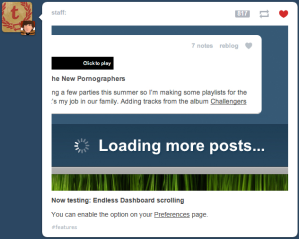Tumblr’s Innovation in Assembly
This post focuses on Tumblr and O’Reillys next pattern of Web 2.0 Innovation in Assembly. What’s great about the new world order of the internet are web services. These web services which have eliminated the need for a presentation layer for business applications and, as Chris Peiris explains, allow businesses to concentrate on their core business while allowing applications to access their back-end data and services. Tumblr allows this with their (flexible) and ReST-ful API (Application programming interface) which they pride themselves on. The platform ecosystem consists of data and services and the APIs which plugin to that data and those services allowing access.
The web itself is replacing desktops as a platform. Individual websites are becoming platforms (see Amazon’s move into AWS) and platform components themselves. Businesses in the development industry must now consider not only an application strategy, but also a platform strategy, (which BMW are looking to focus on to bring a seamless experience to customers driving experiences according to reports from VeritcalCloud). You need to offer APIs to your service as they are the core of this strategy. Using an API developers can create programs which can access the platform (service) and the backend databases. This is the shift: proprietry desktop platforms have diminished with websites becoming dynamic (existant as a point and time and never static, which Rob May puts so eloquently) and service offering as well as the emergence of open source development initiatives. Tumblr itself is forever evolving with each new post, new like, new reblog your dashboard changes – and you scroll down further and what was the borders of your website are then expanded. This is dynamic content – this is Web 2.0.
Now some of the big benefits of platforms are that:
- They provide a scalable growth model (think pay-as-you-use or read Janet Dillione’s thoughts on how this could provide savings for the health industry). This is a very cost efficient business model and with Tumblr this is evident – you’re only hooking into what responses and methods you’re calling. They have spent the capital on the underlying infrastructure and allowed easy access to their service in an effort to generate a network effect – this environment that allows easy media upload and sharing and collobaration and remixing and mashup – it just couldn’t be possible by developers working on their own. That type of big data and highly intensive IO needed for these web applications require a lot of startup dollars..
- APIs foster third party innovation (see these Tumblr developers and their mashups), allow data to be taken apart, and mashed up or remixed. Think – I don’t want that person’s whole tumblr site, I just want their video posts. And better yet, I only want to call their video posts that have had one hundred likes! That is the power of APIs, you get the smallest possible unit that is uniquely addressable.
- Open platforms build trust and community (check the Tumblr API discussion Google group) – Tumblr feeds themselves can be syndicated with RSS all over the web and within any accessible web service.
- Customers show you how services are really used, (see the mashups and discussion group above or send an email direct) – the tumblr staff themselves were the original customers (Self-users) and are one of the most followed people on the site; and
- Revenue models can be directly tied to a platform.
Of course there are some risks with using APIs and Tumblr is no different; they are provided as-is in most cases and the terms of service agreements are not weighted heavily in the protection of devlopers interests. Tumblr have released new APIs and developers need to update their applications to (as Hootsuite showed earlier this month). In a lot of cases an updated API can create a broken web application for a developer if they aren’t ahead of the update. In this fast moving Web 2.0 world you need to stay up to date. It’s good then you can subscribe to the API’s RSS feed 😉
References:
Dillione, J. (2011). Cloud Computing: Healthcare Savings, Accessibility and Opportunity, from http://tinyurl.com/848s59c
HootSuite. (2012). HootSuite Updates Tumblr and Trendspottr in the App Directory, from http://tinyurl.com/7fd2lhv
May, R. (2012). Dynamic Web Strategy and The Failure Of Best Practices, from http://tinyurl.com/6nbdt6z
O’Reilly, T. (2005). What Is Web 2.0, from http://tinyurl.com/84jykg6
Peiris, C. (2008). Creating a .NET Web Service, from http://tinyurl.com/7rfbjm5
VerticalCloud. (2012). BMW adopts open platform strategy, from http://tinyurl.com/8ycmsbo

Nice to know about Tumblr. I like it because all blogs are full of creative art as it is one of my interest. With first look, It seems like another blogging website. How do you compare it with wordpress?
I have posted about Innovation in Assembly http://goo.gl/lr34q, will appreciate your views about it.
Yeah the creative side of tumblr is what I like as well 🙂 Not a lot of restrictions which allow people to express themselves quite abstractly. It’s different to wordpress because of the ability to post content quickly and through different input methods (apps, browser buttons, mobile apps, call-to-post). WordPress has this but they aren’t very accessible. Also the main feature of tumblr is the ‘Like’, ‘Follow’ and ‘Re-blog’ features which are the basis around the whole community. This is how content can be circulated quite rapidly (unlike wordpress which needs to be trawled from a search engine or blog directory to be found – or someone could be already subscribed to the RSS feed).
I’ll go have a look at your article 🙂
Tumblr is just one of those successful web applications that cleverly designated their resources and in turn have the users and developers help expand and innovate the site. Good example.
Pingback: Urbanspoon is Above The Level of a Single Device « Web 2.0 Applications